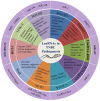Roles of long noncoding RNA in triple-negative breast cancer
- PMID: 37795578
- PMCID: PMC10652353
- DOI: 10.1002/cam4.6600
Roles of long noncoding RNA in triple-negative breast cancer
Abstract
Introduction: Long noncoding RNAs (lncRNAs) play crucial roles in regulating various hallmarks in cancers. Triple-negative (Estrogen receptor, ER; Human epidermal growth factor receptor 2, HER2; Progesterone receptor, PR) breast cancer (TNBC) is the most aggressive form of breast cancers with a poor prognosis and no available molecular targeted therapy.
Methods: We reviewed the current literature on the roles of lncRNAs in the pathogenesis, therapy resistance, and prognosis of patients with TBNC.
Results: LncRNAs are associated with TNBC pathogenesis, therapy resistance, and prognosis. For example, lncRNAs such as small nucleolar RNA host gene 12 (SNHG12), highly upregulated in liver cancer (HULC) HOX transcript antisense intergenic RNA (HOTAIR), lincRNA-regulator of reprogramming (LincRNA-ROR), etc., are aberrantly expressed in TNBC and are involved in the pathogenesis of the disease. LncRNAs act as a decoy, scaffold, or sponge to regulate the expression of genes, miRNAs, and transcription factors associated with pathogenesis and progression of TNBC. Moreover, lncRNAs such as ferritin heavy chain 1 pseudogene 3 (FTH1P3), BMP/OP-responsive gene (BORG) contributes to the therapy resistance property of TNBC through activating ABCB1 (ATP-binding cassette subfamily B member 1) drug efflux pumps by increasing DNA repair capacity or by inducing signaling pathway involved in therapeutic resistance.
Conclusion: In this review, we outline the functions of various lncRNAs along with their molecular mechanisms involved in the pathogenesis, therapeutic resistance of TBNC. Also, the prognostic implications of lncRNAs in patients with TNBC is illustrated. Moreover, potential strategies targeting lncRNAs against highly aggressive TNBC is discussed in this review.
Keywords: chemotherapy resistance; long noncoding RNAs; pathogenesis; prognosis; radiotherapy resistance; targeted therapies.
© 2023 The Authors. Cancer Medicine published by John Wiley & Sons Ltd.
Conflict of interest statement
There is no conflict of interest among the authors.
Figures


References
-
- Waks AG, Winer EP. Breast cancer treatment: a review. JAMA. 2019;321(3):288‐300. - PubMed
-
- Kumar P, Aggarwal R. An overview of triple‐negative breast cancer. Arch Gynecol Obstet. 2016;293(2):247‐269. - PubMed
-
- Schmadeka R, Harmon BE, Singh M. Triple‐negative breast carcinoma: current and emerging concepts. Am J Clin Pathol. 2014;141(4):462‐477. - PubMed
-
- Weigelt B, Eberle C, Cowell CF, Ng CK, Reis‐Filho JS. Metaplasticbreastcarcinoma: more than a special type. Nat Rev Cancer. 2014;14(3):147‐148. - PubMed
Publication types
MeSH terms
Substances
LinkOut - more resources
Full Text Sources
Research Materials
Miscellaneous

